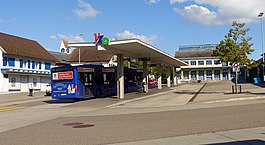Oetwil am See
| Oetwil am See | ||
|---|---|---|
 |
||
|
||
| Coordinates: 47°16′N 8°43′E / 47.267°N 8.717°ECoordinates: 47°16′N 8°43′E / 47.267°N 8.717°E | ||
| Country | Switzerland | |
| Canton | Zurich | |
| District | Meilen | |
| Area | ||
| • Total | 6.1 km2 (2.4 sq mi) | |
| Elevation | 538 m (1,765 ft) | |
| Population (Dec 2015) | ||
| • Total | 4,661 | |
| • Density | 760/km2 (2,000/sq mi) | |
| Postal code | 8618 | |
| SFOS number | 0157 | |
| Surrounded by | Egg, Grüningen, Hombrechtikon, Männedorf, Stäfa, Uetikon am See | |
| Website |
www SFSO statistics |
|
Oetwil am See is a municipality in the district of Meilen in the canton of Zürich in Switzerland. It is located in the Pfannenstiel region.
Oetwil am See is first mentioned in 847 as Uttinwilare.
Between 1909 and 1949, Oetwil am See was connected to Uster by the Uster–Oetwil tramway and, between 1903 and 1950, to Wetzikon and Meilen by the Wetzikon–Meilen tramway. The two lines met at Langholz, in the south of the municipality.
Oetwil am See has an area of 6.1 km2 (2.4 sq mi). Of this area, 67.8% is used for agricultural purposes, while 12.3% is forested. Of the rest of the land, 19.7% is settled (buildings or roads) and the remainder (0.2%) is non-productive (rivers, glaciers or mountains). In 1996[update] housing and buildings made up 14.1% of the total area, while transportation infrastructure made up the rest (5.6%). Of the total unproductive area, water (streams and lakes) made up 0% of the area. As of 2007[update] 16.7% of the total municipal area was undergoing some type of construction.
Oetwil am See consists of the villages Oetwil am See, Willikon, Etzikon, Summerau and Chrüzlen.
Oetwil am See has a population (as of 31 December 2015) of 4,661. As of 2007[update], 25.8% of the population was made up of foreign nationals. As of 2008[update] the gender distribution of the population was 49.6% male and 50.4% female. Over the last 10 years the population has grown at a rate of 11.1%. Most of the population (as of 2000[update]) speaks German (82.3%), with Italian being second most common ( 3.8%) and Serbo-Croatian being third ( 3.0%).
...
Wikipedia



